The Electronic Studio
Step-by-Step Graphics, Vol. 5, No. 2, January 1989. Milwaukee, Wl: Dynamic Graphics, pp. 166-179 SECTION EIGHT 168 Going Electronic – What You Need to Know; PC or Mac; Input/Output Devices; Custom vs. Turnkey; Networking; Software; Memory; HyperCard; Implementation 170 Case Study: – WYD The Integrated, Automated Studio 177 Marriage of Computers, Color Copiers and Faxes […]
Step-by-Step Graphics, Vol. 5, No. 2, January 1989. Milwaukee, Wl: Dynamic Graphics, pp. 166-179
SECTION EIGHT
168 Going Electronic – What You Need to Know; PC or Mac; Input/Output Devices; Custom vs. Turnkey; Networking; Software; Memory; HyperCard; Implementation
170 Case Study: – WYD The Integrated, Automated Studio
177 Marriage of Computers, Color Copiers and Faxes
178 Scanners
179 Laser Printers
180 Case Study: FGB How FGB Learned to Love Computers and Stop Worrying
182 Configuring a Mac II Workstation
The Electronic Studio
Learn where to position your studio in today’s integrated world of information processing.
Five or ten years ago, it was debatable. But today, we can say with confidence: The graphic design studio is going electronic. And what better evidence of this fact than our own Step-By-Step Electronic Design a new publication that premiered in January, 1989, devoted exclusively to designing on the desktop. It was created in part to satisfy many of the repeated requests made by readers of this magazine for more specialized how-to information.
By far some of the most popular questions among reader requests are those relating to computer equipment selection and outfitting.
For example, a rather perplexed designer wrote in recently to report that some of his colleagues tell him the Macintosh is the best, and that he should not consider anything else “But still others say IBM PC systems are just as good. So what kind of hardware and software should I buy?” he asked.
Motivated by that question and many others like it, we decided to include a section on the electronic studio in this Annual Designer’s Guide (even though it probably will be the exclusive subject of next year’s annual). This section’s purpose, however, will not be to provide you with a laundry list of recommended hardware and software. Authors Mihai Nadin and Barbara Nessim stress: “It is not a collection of brand names nor a list of products, but a systematic approach to the whys, whats, hows, and even whens of outfitting your electronic studio. Instead of prices (at vendor or street level), we will concentrate on stakes; instead of “canned” answers, we will provide strategies appropriate to the creative goals of the electronic studio.” (You can turn to the articles following theirs for specific case histories and working studio configurations.) – The Editors
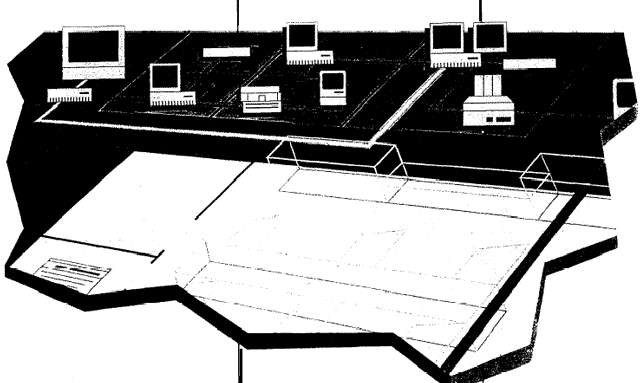
The Automated Studio Weisz Yang Dunkelberger, a design studio also in the business of helping other firms outfit their electronic studios, firms like Caterpillar Inc., The New England and The National Wildlife Federation, developed this configuration to match their integrated office needs. This blow-up of the firm’s layout shows how WYD’s computers are linked up. For more on the firm, which lists among its design clients Champion Paper, Lone Star Industries and ITC, see “The Integrated, Automated Studio” later in this section.
As more computer publications are made available, more workshops for creative users are offered, and more electronic consultants are knocking at our doors, graphic designers are becoming confused. Some hope that the electronic age will become a thing of the past, and that computers will behave like pencils, rulers, markers, X-Acto knives and any other graphics tool. It is a wild, new world out there, with a new lingo, strange players, and promises as high as the sky although fulfillment sometimes seems disappointingly low.
WHY AN ELECTRONIC STUDIO?
Before jumping into the fray, designers, illustrators, art directors, publishers and advertising agencies should understand why electronics and digital technology are important for their creative or production work. There are economic reasons, such as increased productivity and shorter production cycles, as well as designspecific reasons, such as access to a vast number of expressive means (including typefaces, visual libraries that are broader than the traditional clipping file, the generation of 3-D images and animation). But most important is the new world of complex interconnections which not only require design as we know it, but also open up new design possibilities. A studio that goes electronic only because the competition did or because some vendor made it sound so attractive, or even because hard facts showed them that the same work can be done with computers, has missed the main justification for the electronic studio-that is, it is a whole new way of doing business in a new working environment.
Whether we are developing annual reports, corporate identity, book illustration, interior design, advertising or packaging, we work in a world where information is produced and exchanged at rates never before experienced-witness the number of TV screens, computer terminals, fax machines, and microwave and satellite dishes. What we do not have is an understanding of the new demands this places on the graphic artist.
INFORMATION EXPANSION – In simple terms, this means that future customers will select a designer based on his or her ability to receive and process the data. Customers, especially those heavily involved in information processing, can download text, tables and diagrams to the design offices working on their publications. Indeed, we are not far from the time when the “electronic” annual report, an on-line, real-time report of a company’s financial position, will be designed to be made available 365 days of the year. This means that designers will not only prepare the printed report, but the electronic report as well, then update it and maintain its visual integrity and appropriateness. Studios no longer limit their work to the printed medium, but can expand t o video, computer animation and computeraided product design and simulation. By incorporating digital photography, designers can use images that can be transmitted electroni-cally from any part of the world, and then use the same image in video and television formats.
INCREASING CONTROL – All this means that the electronic studio has to be set up with these new technological relationships in mind. Moreover, the technology making up the electronic studio will permit formerly separate activities to be joined. For example, since type in a digital format is so readily available, even artists who preferred to commission typography will become more directly involved with it, experiment with type and refine it in house. For example, one software program, Fontographer (Altsys Corp.), lets you create your own type. Another program, LetraStudio (Letraset) allows you to manipulate Letraset display faces in a variety of ways. With access to digital art, layout and type tools, designers and illustrators will be able to exercise more control over the total final product, not just an individual image or page design. In turn, they can expand their client base.
CHANGING ROLES – Graphic designers anywhere in the world today can interact and interface with clients, from the sketching phase to the fmal product. This leads to what some call “clientaided design.” Billing, budgeting and expense accounts can be documented and executed as the job progresses.
One consequence of all this is that the function of the art director has already begun to change. He or she works in new ways with copywriters, artists and account executives, and can be more demanding, more precise and more creative. Art directors can interface with clients through presentations other than the classic slide or video show; and they can accommodate client preferences more easily by using image transmission. Therefore, it makes sense to set up the electronic studio with this larger business context in mind.
INTERDISCIPLINARY DESIGN WORK
Today we have the means to overcome the excessive segmentation and specialization that have affected design activity for some time. The electronic studio is increasingly the centerpoint for interdisciplinary work Figure 1 shows how previously independent tasks (corporate identity, advertising, packaging) are more integrated, and also suggests new relations between the market and design companies. In order to take advantage of all these opportunities and to understand their implications in terms of the investment that the electronic studio requires, the first question should not be “What kind of machines do I need?” but rather, Where do I position my studio in today’s [and tomorrow’s] interconnected and integrated world of information processing?
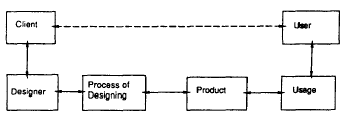
Fig. 1.
Connections between client and designer, designer and product, and even product and user are increasingly taking on an electronic overtone. This means that the electronic studio needs to support communication with the outside world, where our work is needed and where it originates as well as creative interaction with various artists and designers inside the studio. No piece of equipment should be examined without considering these two levels of communication.
THE IDEAL VS. BASICS – In order to design an electronic studio, we have to know what we want-the ideal-and what trade-offs are acceptable. If we are not aware of the limitations of technology and expect things beyond its capabilities, we will soon be frustrated. Knowing the limitations of technology is as important (if not more so) as knowing its possibilities. In principle, an electronic studio is as simple as Figure 2 shows.

Fig. 2.
Obviously, the question mark in the box is part of what you want to see answered in this article. But remember: All computers are equivalent. What makes them so diverse are characteristics such as memory, CPU cycles, speed, and compilers or interpreters. An electronic studio is a place where designers use electronic technology, but not where they invent it or even program it.
IBM-PC OR MAC?
There are two basic modes of operation represented by the IBM-PC (and its clones) and the Apple Macintosh. And it is your personality and work style that will ultimately defme your choice, not popularity, price or vendor persuasion. Computer use in an electronic studio covers several areas, but can basically be defined as editing. The designer wants to format (actually, to design) something: text, images, solid models. This can be accomplished in two ways: First, by asking the machine to do it, or second, by using interactive editors and performing the operation yourself. (See Figure 3.)

Fig. 3.
BATCH OR INTERACTIVE EDITING? – IBM-PCs use batch editing, which requires that the designer specify characteristics of the image, usually in string format (convoluted text, abbreviations of technical words) so the computer can execute ‘the order. Macs use an interactive editor, usually in the category of What you see is what you get” (WYSIWYG), in which the computer keeps count of the changes made by the designer and displays the edited document almost instantaneously. Batch editing requires typing in instructions. Interactive editing requires knowledge of operations (mainly the use of a pointing device, such as a mouse) and certain editing skills.
Which is better? The one that suits your characteristics best. A batch editor is perceived to be slower, but revisions are made throughout the document. You define what you want. With the interactive editor, the revision process is not entirely automated, so changes have to be made by the designer. The complex electronic studio will most likely find a compromise between batch and interactive editors since some designers will prefer one editor over the other, but all must be able to communicate and exchange files with colleagues. Networking provides a communication protocol for this purpose. (See Figure 4.)
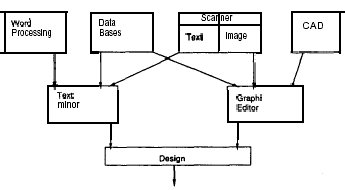
Fig. 4.
THE INTEGRATED, AUTOMATED STUDIO
Even though Weisz Yang Dunkelberger is now in the business of helping other firms automate, converting their own operation was not that simple at first. “Planning and buildlng an integrated electronic design studio was a little like Magellan and his first trip around the world. We firmly beliwed the world was round, but there were no charts or maps to guide us. And part of our crew had to be dragged on board kicking and screaming!” says David Dunkelberger. Getting started was half the battle. When Weisz Yang Dunkelberger bought their first computer, an IBM-based paint box, it mostly,sat in a room by itself. “the system ended up being a very expensive toy. The output was crude by today’s standards, and yes, the type was awful, but we gained an understandlng that still works today,” Dunkeiberger, partner and senior designer, says. We made that early commitment and have continued to push the edge of technology for the same reasons: First, the tools inherently provide new opportunities and avenues of creative expression; and second, by combining input, design and production processes into a seamless flow of information, we’ve found substantial competitive and productivity gains.”
In addition to being a design studio, Connecticutbased Weisz Yang Dunkelberger offers consulting services to clients who wish to automate their design departments, in-house processes or specific projects. For this reason, the firm must stay on top of the latest developments in hardware and software. And due to the group’s close working relationship with many developers, the studio enjoys the use of a variety of devices and programs.
But this top-of-the-heap mentality evolved gradually. “It’s definitely not a normal studio situation,” says Dunkelberger, “and that should be kept in mind when considering the equipment [we use].” The firm��s set-up does represent an ideal, howwer, and for this reason, Step-By-Step Graphics asked the firm to outline the components of its electronic design studio.
SEPARATE WORKSTATIONS – We have physically separated the computer design workstations from the drawing boards by moving them to a room with less light: says Dunkelberger. `The ambient lighting requirements are different, and our designers tell us they like the break of moving from one location to `another. Of course, lots of designers prefer to arrange their computers and drawing boards so that they can spin their chair or stool from one to the other; this proves that there is no best answer.”
HARDWARE – The firm’s three computer design workstations all utilize Mac 11s with 5Mb RAM and 80 to 15OMb internal hard drives and appropriate boards to support 19-inch color display terminals. Additional design work can be done on the nearly one dozen Mac Pluses and SEs which also support their correspondence, bookkeeping, job tracking and mailing lists. A single IBM-PC which was an initial building block on the business side of the studio, is`now used by one of their sales reps. Since it is part of the network, it is also used to enter PC-based word processing text.
INPUT AND OUTPUT – “For black-and-white scanning and optical character recognition, we use the Data-Copy 730. We also use the Howtek ScanMaster for color,” Dunkelberger notes. “We output in all the usual ways-an Apple ImageWriter II for text proofing and other utility grade work; an Apple LaserWriter Plus for high quality text, black-and-white comps and finished correspondence. We currently are using a QMS Colorscript 100 thermal color printer capable of producing 300dpi Post-Script output for comps and other purposes.”
SOFTWARE – The firm has, at one time or another, experimented with many different brands of software. However, the names that reappear frequently in day-to-day production include MicroSoft Word, Page-Maker, Quark, Lightspeed CLS, Image Studio, Illustrator 88, Freehand, Pixel Paint and Video Works, among others. Apple Local-Talk running on TOPS ties their computers together, although designers are allowed ample freedom in selecting their own desk accessories and utilities. We use Microsoft as our standard,” says Dunkelberger, “and HyperCard and MicroSoft Works for planning.” He adds that they are currently experimenting with accounting software, but have had some difficulty locating a program developed excluslvely for the design studio.
GETTING STARTED
Weisz Yang Dunkelberger found that initially it had the same arguments against computerization as did many of its clients. The old notion that all you need to open a design office is a drawing board and a portfolio is still prevalent. Comments like, “It’s hard enough to make a buck as it is-why turn my business into a capital intensive operation?” are frequent, and from those who are already successful, “If it ain’t broke, don’t fix it!” Howwer, Weisz Yang Dunkelberger knew that its clients were already using computers in virtually all phases of their businesses: word processing, accounting, project management, manufacturing, research, and so on. Consequently, the firm reasoned that their computer literacy had to extend beyond a simple hand-held calculator. While the firm’s principals admit that it has taken a great deal of time and money to make a longterm commitment to computers, they also note that the rewards go beyond creative freedom and enhanced productivity. We’ve identified new services to provide to corporate clients as their needs evolve, including electronic guidelines for internal publications, animated and computer-based presentations, global teleconferencing of design, and digital photofile management.”
AND THEN CAME THE MAC – Implementing Macintosh and compatible equipment made WYD`s transition to computers less painful. “The Mac was the first computer to transform technology into romance; says Dunkelberger. “Sit any designer in front of a Mac and the seduction begins. Fortunately, Apple and third party developers have continued to build better and more powerful machines without sacrificing friendliness. The Mae is still fun and the options have grown tremendously.” Modularity was the key to building their Mac-based design office. “We�’ve got over a dozen Macs: Pluses, SE’s and Il’s, each with well-defined functions. Large screen monitors are used for page layout, color monitors for comps scanners to bring in photos and art, high resolution printers for black-and-white or color printing. The conference room has a 37-inch monitor for presentations, and we use the fax and modems for telecommunications. Everything is tied together in a local network so we can pass information or designs back and forth,” he adds. (See Figure 1.)
New technology has also brought a wide range of output options. The firm can produce electronic comps using black-and-white or color laser print designs which can then be modemed to a client’s screen or to a f a x machine with Apple’s FaxModem, all with a cover letter if desired. Thii same data is used to run a Linotronic for high resolution output or for generating final fihu for offset printing.
Added to the team’s arsenal is “on demand” dummy type in any font or size, black-and-white laser or color thermal layouts, and complex color Post-Script illustrations and charts. They can also produce presentations and “slide shows” that are electronic, in color, storyboarded and scripted as a unified whole. In emergencies, they have received text via modem in the morning, gotten design approval and Linotronic output by mid-day and ovemighted a-mechanical by 6 p.m. Forms, office communications and client and vendor databases are also all computerized.
“Most importantly, according to Dunkelberger, “we can speak our clients’ language. We can efficiently service our clients by a better understanding of their technological needs and problems.”
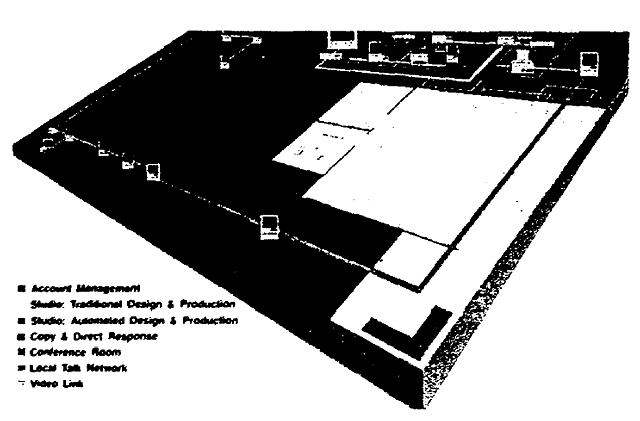
Figure 1
This illustration shows how the traditional and automated sections of Weisz Yang Dunkelberger’s studio are separated by function, but are connected by technology. Drawing tables, files and general work areas are at the hub of the business; the firm’s computers are kept around the perimeter, tied together with video and talk hookups.
SYSTEM LIMITATIONS – The Weisz Yang Dunkelberger crew admits a computerized system has its limitations. First, without training, the computer can be very seductive. One of the most dangerous things a designer can do, according to Dunkelberger, is to “let the box take charge and start dragging him or her around by the mouse.” He says the classic symptoms of “over-involvement” are: Underestimating the cost or time of a project because you will be producing it on a Mac; Losing an hour’s work (or more) because of a power failure; Scanning in every photo when, in fact, it would be a lot faster to just run over to the photocopier; Coming down with the fatigue, eyestrain and headaches which accompany overly ambitious sessions at the terminal.
“Just because designers automate doesn’t mean they will give up everything they knew,” says Dunkelberger. “We still sketch, do cut paper and C-print comps, use the airbrush and ruling pens, and occasionally even spec type. Knowledge of production and printing processes are even more important now that the Mac has increased the options.
“Since every project is different, I use the term. `gidawyc’-`get it done any way you can’-to explain how we approach design.
We are always running back and forth from the photocopier to the scanner to get dummy type out of the LaserWriter, so there is a total integration between automated and non-automated says Dunkelberger.
Despite the negatives, Weisz Yang Dunkelberger has found how technology benefits business, extends creativity and sharpens the competition. But when advising each new client that is interested in design automation, the firm stresses that it is crucial tofind a unique fit. Not all hardware and software will work well in each office But the proper outfit can prove very beneficial “In the old days, we would start a project with limitations,” concludes Dunkelberger. “Not just the parameters of the piece, but design limitations dictated by the budget. Technology has removed much of this baggage. Serendipity has re-entered our methodology. Computers only help to develop communications creativity will continue to define design.”
batch or interactively). Deciding which editor to use should be based on the people who will use the technology, the positioning of the business within the market, the characteristics of the design work, and, to a great extent, from the knowledge of what kinds of programs are available. (Good programs will become increasingly available in both IBM and Mac formats.)
OUTPUT – The next issue to consider when choosing a system is the output of the design work. Simple documents (newsletters, proposals, reports, and so on) can be generated on systems with embedded graphic rules. Actually, this part of the design market has been taken over by non-designers using desktop publishing. Although interactive editors are easier to use for the nonprofessional, it might be preferable to control the choices and let the machine perform the operations considering decisions will be made by people with less design knowledge. At the level of professional publishing, for which an electronic studio can be set up, the designer expects greater flexibility and productivity, more functions and better integration of the required tools.
Another important consideration when deciding between an IBM-PC and a Mac is the integration of color and the capability to produce output not only in printed form, but also in video formats, laser disk, animation and film.
The following items merit consideration before any decision is made:
– How many characteristics of a design would need changing, and how well does the selected technology support such changes? The answer should be based on design experience.
– How do designers in the studio actually indicate modifications, and is the chosen technology compatible with this style?
– Can such modifications be easily understood? How many of the changes can the machine support? Can the chosen technology keep track of collateral changes (such as budget, timeframe, necessary mate- rials, and so on) from design revisions asthey occur?
INPUT DEVICES
How do we make specifications for electronic devices based on existing design needs? The electronic studio is a design environment where, in principle, everything can take place elec- tronically. Accordingly, input devices should “transform” material into data. We distinguish among several categories of such devices: scanners, digitizing tablets, laser disks, digital video cameras and electronic cameras. They are used to convert visual resources of any kind (clip files, artwork, photographs, and so on) into a digital form that designers can manipulate electronically.
SCANNERS – Scanners come in two basic categories: conventional and digital. On a conventional scanner (the kind you find at your color separators, for example), the image is mounted on a drum and is scanned by a laser beam. As the drum turns, the image is sampled-usually 300 to 500 samples per inch-and four optical signals are detected and passed through red, green and blue filters. The resulting information is a measure of the density of light. For scanning images into the computer, picture information must be converted into digital information. Conversely, digital scanners submit artwork, which is mounted on a flat bed, to optical sensors constituting a chip. The red, green and blue values are read simultaneously. In both cases, color correction (adjustment of tonal range, removal of color casts, local area color changes) can be performed.
DIGITIZERS – Digitizers are less elaborate devices. They use a video camera and software to translate photographs, charts, sketches, slides, and so on, into digital information. At the lower end of the spectrum, intelligent digitizers can be used for combining several sources of images. Tracing given images (maps, portraits, diagrams) on a digitizer tablet is the most common form of their use.
OTHER SOURCES – Other input devices include laser disks, which contain tremendous amounts of images, all available for use in new designs, for manipulation or for animation. The electronic studio can actually hook up to libraries of images from all over the world, using, in most cases, original work, not second, third, or fourth generation reproductions. Once such images are stored, the designer uses them in a layout, performing image processing, or by creating new visual interpretations of the original image. For all this to happen, the designer needs machines with adequate memory for storage, good programs for retrieval and manipulation, and even better programs to output the resulting image.
OUTPUT DEVICES
Output devices include printers, scanners (again), displays, plotters, cameras (electronic or otherwise), film, video, laser disks, and typesetters, among others. We associate CRT (cathode ray tube) displays with computers, although not every computer has a CRT or needs one. It is up to the designer to define what kind of display better suits his or her creative needs. Obviously, not every display is compatible with the computer used, and not every computer can output images of the size and resolution needed. The small Macintosh screen results from computing requirements, not because the designers of this tool did not know that much better results could be obtained with a bigger display. On the other hand, buying the best screen and hooking it up to a machine that cannot manage the information display will only result in a distorted image.
LASER PRINTERS – From among all the printers available (dot matrix, daisy wheel, ink jet, and so on), the laser printer brought electronic technology closer to the studio. The laser offers better resolution than dot matrix printers can, as well as the output of complete (text and image) pages. It also allows for accurate line art and halftones, digital control of point sizes, and, for the first tune since digital technology approached the old art of typography, control of word- and letterspacing. In short, lasers made possible exact copy proofing and even final output for shortrun jobs. Today, laser-printed jobs are acceptable and economically feasible for many projects.
POSTSCRIPT – But the laser itself is not what made laser printer quality possible. It was a new language called PostScript (Adobe). When PostScript was saluted at the 1985 Pratt Seminar in Computer Graphics, I declared it a breakthrough for computers in design. The very existence of PostScript made desktop publishing possible. (See Figure 5.) PostScript is based on a good understanding of what defines an image and how people working on the image actually carry out their duties. The language is used to drive a laser printer or a typesetting machine in order to produce type, images or complete pages of high quality. For those interested in word processing only, Post-Script is relatively slow.
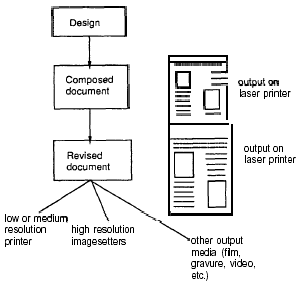
Fig. 5.
RESOLUTION – A laser printer commonly supports a resolution of around 300 dpi (dots per inch), far from the resolution of professional typesetting, but good enough to look like printed matter. Digitally driven typesetting machines, called imageset- ters by desktop designers (such as Linotype, Compugraphic, Autografix and Varityper) run to higher resolutions, offering a choice of medium-low (above 600 dpi), medium (up to 1,200 dpi), and high resolution (above 1,200 dpi). The higher the resolution, the slower (relatively speaking) the machine’s setting.
SPEED – As far as speed is concerned, a laser printer can produce between eight and 16 pages per minute. Imagesetters, on the other hand, are slower, containing a high speed raster image processor that converts text data, pictorial data, line copy and halftone data from scanners into the format needed for laser printing on photographic paper, film or paper.
SPECIALIZED OUTPUT DEVICES – Some rather sophisticated pieces of electronic technology, which rarely make it into the electronic studio described here include machines that allo wstorage of images on laser disks a s well as copper engraving (gravure), which permits high speed printing on vast gravure cylinders. Such output devices exist, and the electronic studio will probably have to provide communication links which support full page transmission. Although they are expensive, they should be considered available production tools, easy to reach via electronic communication. Laser disk technology for printing will probably be the next medium for storage or for integrated software applications. The two categories are known as CD-ROM- compact disk read only memory and WORM-write once read many times memory.
SHOOTING PRINTS AND SLIDES – Many computer users shoot images from the screen. However, a little education can lead to better quality. Instead of capturing the image along with its accompanying flicker, and at the mercy of screen color cali- bration, it makes sense to use electronic cameras in which signals, correctly filtered, are used to produce a Polaroid or film. There are a variety of these cameras, which, although they require precise adjustment, make available the control of color, tint, sharpness, brightness and contrast. Raster-fill technology fills in the spaces between raster lines on screen, smoothing the image. The best known camera is a Freeze Frame recorder from Polaroid (developed with Toshiba). Matrix and Laser Graphics are also reliable sources. Output on magnetic tape or on plotters (important to studios producing architectural or product design, and packaging in particular) can also be pursued. Even video output and animation are possible.
COLOR OUTPUT – A complete color prepress system requires color separation capabilities (for which scanners work well), color correction capabilities (available on scanners), halftoning (also known as screening), electronic retouching, page layout and electronic assembly. Due to the difference between color on screen (a mixture of light) and color on paper (a mixture of pigments) it will take time before what we see on the screen is the same as we get on paper. It should be pointed out, to those eager to consider color printing in the electronic studio, that the new color technology will require quite a bit of training and retraining.
INTEGRATION VS. TURNKEY SYSTEMS – Because navigating in the world of customized, integrated systems requires knowledge, initiative and some acceptance of risk, many designers are inclined to explore an easier way out. Some studios have turned to the large turnkey systems in which various functions are put under the name of one product; still others have assembled Macintosh or IBM equipment along with special software to interact with t hese larger systems. Among the systems used in studios today are Lightspeed, Scitex (watch for the new Visionary software, a version of Quark Xpress that links up to the Scitex), Xyvision, Interleaf, Canon Express and AGX from Compugraphic. They are not equivalent in their functions and not at all comparable in price. But if you prefer the route of personalizing your own environment, there are other alternatives. For example, consultants will help you find the systems you need, or at least the ones that come the closest to your expecta- tions. In fact, some of the nation’s leading design firms have gone through this difficult task of discovering the virtues of new technology themselves and are today offering consulting services- a new line of business which provides a return on their past investment in technology. Two such firms are: Weisz Yang Dunkelberger, Inc. (Westport, Conn.), and Frankfurt Gips Balkind (FGB, N.Y.). Case studies featuring their operations accompany this article.
NETWORKING
Without entering into the details of what it takes to integrate various input and output devices (also known as peripherals), computers and other machines, it should be pointed out that digital communication requires networking-that is, communication protocols, access codes and software- for reliable transfer of information. Whether you opt for a batch or an interactive edi- tor, it will influence your networking choices. You must decide if you want. to distribute your resources or share some (such as databanks of images, digital typefonts, printers and scanners). This will also influence your networking and integration choices. (See Figure 6.) A network facilitates communication between various computers and electronic devices that are used in the studio. Each of the boxes is a so-called node (computer, scanner, printer, and so on). Due to the fact that there is little standardization in technology, the difficulty is to find the hardware and the software necessary to support communication among machines adopting different standards. Communication of data supporting visual processing requires a high speed of data exchange and broad band for moving complex information. Both high speed and broad band are expensive, but some compromises can always be made. Ethernet- our example-is a standard communication medium for local area networks (known as LANs) which has a “bus” configuration (a single cable open at both ends). It makes data accessible to almost any kind of computer-the Mac’s, the IBM’s, the Sun and Apollo workstations, the popular VAXes, and many others. The connection among various machines in the studio depends upon whether a database of images and information, for example, is shared or if various designers will exchange information during the creative process. In the first case, a network file server (a computer with sufficient storage) is necessary; in the second, an Ethernet backbone linking separate groups, themselves connected with the help of twisted pair wire or some other connectors (such as the fiber optic AppleTalk, or the Phone Net) is necessary. The advantage of Ethernet is multiple protocol support; that is, it accepts various communication languages (such as the Apple proprietary protocol, DECnet, or TokenRing). It is beyond the scope of this article to show the specific Ethernet for the studio, but a diagram is again useful as a way of suggesting all the possibilities. (See Figure 7.) As an example of determining networking needs, when American Express introduced its integrated system for processing card charges, it had to specify that scanners would read the slips. The information from the slips would go to billing, and everything would come out as a clear laser print whose electronic copy would be stored on laser disks. It sounds simple now, but it required that Ameri- can Express define an information flow and how various people would interact with the information. Similarly, if an electronic studio receives data from the client by way of digital communication, and then starts integrating it (in annual reports, advertisements, brochures or video), it makes sense to have enough “visualization” stations to provide access to the data for addition and manipulation. But it also makes sense to store the results for at least two reasons: for future use and for the record (as it supports billing, presentation and evaluation). We have given American Express as an example back to back with the example of the electronic studio not to suggest analogies between their activities, but to make clear that specifications for the network reflect the work in the studio. Creative interaction of artists should take place through images, interactively, fast, reliably. Interaction with clients should make transparent what the artist intends and how the commission is carried out.
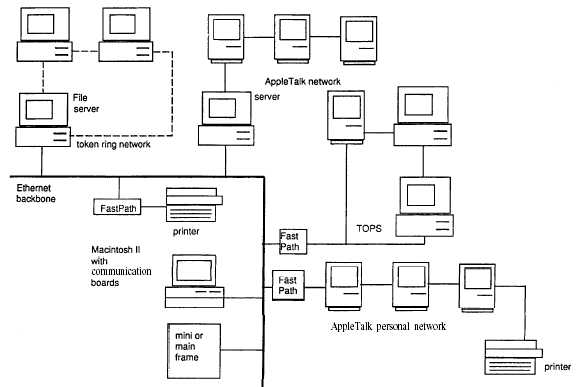
Fig. 7.
A GENERIC CONFIGURATION
A generic configuration of an electronic studio, such as the one shown in Figure 8, brings together the various functions with which artists and designers are familiar. In a sense, this configuration spells out all the elements discussed so far.
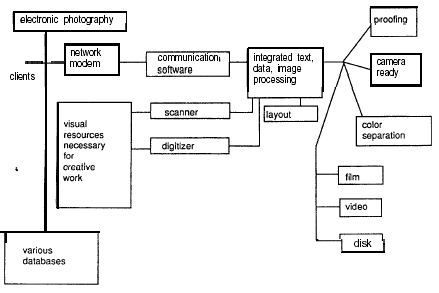
Fig. 8.
In the case of specific applications (packaging, animation, sculpture), variations will occur. For example, a pneumatic, digitally controlled cutting table, which is an extension of the plotter, allows for the output of the package and its immediate assembly along fold marks. In animation, cel backgrounds, ink and fill, and in-betweens are necessary. For sculpture, a digitally driven milling machine might prove necessary. Obviously, any computer can process text, data, and images, if adequately programmed. So why would someone prefer an IBM to an Apple, or a DEC to a Sun, or an AT&T to Apollo? Because, as we know from experience, some computers are more equal than others, which actually means that they were designed and built with a certain user in mind. The earlier discussion of batch and interactive processing partially addressed this problem. User interface is another very important aspect. Even more important is the understanding of the complexities of the visual and integrated electronic environment. For many, Macintosh is the machine of choice, Its iconic interface reduces the learning curve, although pro grammers will say that in exchange for the first easy 20 minutes, Mac interface punishes for the next 20 years with difficult use. For others, IBM is the choice, and for more demanding professionals working on very complex creative projects, workstations such as those from Hewlett-Packard Sun or Apollo are the answer. In the little mythology of machines, Scitex is always given as an example of the “top of the line”-but mention is rarely made of the volume of work a Scitex machine needs before it becomes efficient, what training is involved, what maintenance is required as well as some of the system’s intrinsic limitations (resulting from design decisions made at a time when PostScript, for instance, did not yet exist). A Scitex PC is expected in the market. Along with the NeXT machine, it will open new avenues for creative work.
SOFTWARE IS GETTING SOFTER
To understand what kinds of programs are supported by what kinds of machines is to understand that graphics packages supporting visual applications are quite different. The so-called QuickDraw is obviously one of the strengths of the Macintosh. The designer using it does not interact directly with QuickDraw (unless he or she is also a programmer), but can expect a rather fast translation of commands into images, and subsequently into laser printed images. PostScript, which we already mentioned, has the benefit of being a resolutionindependent language, which means that programs using this page description language can be output on a lower resolution printer or higher resolution typesetter. Accordingly, when deciding what programs to use, designers have to pay attention to two criteria: functionality and efficiency. The bitmapped paint programs that we associate with the initial phase of Mac culture (“the computer as a toy”) are nice when one looks for rough brush- strokes, for sketches, and for projecting a computer touch through the imperfect image. But for real quality, which makes the computer invisible in the final work, we need programs different from the ingenious Mac-Paint, different from everything else we have used on our Amigas, AST’s, Genigraphics, Xeroxes, and Artronics stations. We need-and this is a value statement-higher levels of programs, the closest of which are based on Post-Script commands. Design details, such as hairlines, gradual fffls between different gray levels, precise manipulation of text and image and the ability to make up a whole universe of images from various curves and lines, are possible only in the universe of higher level languages, in particular, PostScript (which NeXt uses as a higher resolution display carrier.) At this time, the number of PostScript-based or oriented programs available is limited. A number of new products are in the betatesting stage and there are high expectations. From what is available, you might test programs like Cricket-Draw, Adobe Illustrator, the latest version of PageMaker from Aldus, Letraset’s Ready-Set-Go, Collage from PS Publishing and Laser-Paint. (This is not an exhaustive list.) Combinations of fonts and styles, graduated fills, freehand drawing effects and very precise rotations (in increments of one degree) are some of the attributes you can expect in the PostScript-based drawing programs. They also have a good price/performance ratio. Once the sophistication increases, a freehand drawing tool that can also support conversion of images from other media will be necessary. The import of images from scanners and from other programs is a function of such a program/tool. What results is a very convenient electronic tracing, easy to reshape, and after final editing, easy to move, stack, or fill. Such programs probably do better on bigger screens because the level of detail they allow is not well served on a small screen. Some companies offer clip art col- lections created with such tools, facilitating future creative use (from logotype design to incidental illustrations). Finally, paint programs, which can also be described as integrated programs, go well beyond geometry. They expand the scope of visual work from one to two pages and from four to eight pages. Such programs offer printing features such as registration, trim and fold marks, and perform color separation-all of which are quite important if the studio was set up as an integrated environment. Animation programs are the next step, some used for product and interior design, others for commercial animation. In the context of software tools, scanners need to be mentioned again because the new gray scale (or graylevel) scanners are a direct result of the PostScript environments. Keep in mind that, in the electronic world, resolution decreases as the number of gray levels increases (at this writing, up to 256 levels). Due to the PostScript environment, gray scale scanners are also device independent. Choosing your scanner on the basis of the advantages of the programs you use is not easy. The selection varies in price (the inexpensive Thun derscan and the more expensive Truvel TZ-3 are the extremes), in the feed system (some are video, sheet-fed, flatbed, scanning table), and gray levels. There is a variety to choose from (coming from New Image Technology, Truvel, Microtek, and Abaton, among others) if you really know what you need and how those needs determine your configurations. (See the list of scanners next to this article.)
MEMORY
Be aware that the complexty of the visual is not accounted for only in the complexity of the programs, out also in the CPU requirenents, memory and output. `t is quite common that such programs require the class of computers based on new chip technology (32 bit, 15- 25 MHz, 3-5 MB in RAM). A color image in 256 colors for which the Mao II or any other computer needs a ideo card) requires one to our MB’s of storage. Before you know it, you have filled your memory and you start getting warning messages or cperiencing crashes. However there is help for this in the form of optical memory vrite once, read many- OKM) which can hold 50 gabytes. This also encourages the design of videocards offering up to 16.8 million colors As of the writing of is article, programs such the ones mentioned above ere already considering optical mass storage (companies like Discovery Sysms), which is very good news for the design trade.
HYPERCARD
Think about your thumbnail sketches and imagine that by some miracle all your ideas are somehow connected. You say “green apple” and every image you ever sketched containing a green apple is found and displayed. Imagine that this applies to the entire library of images that your studio owns. And imag- ine that you can connect “green apple” and “marble tables” or “steel knives” or even a piece of music or a videotape. This is what the hypertext concept is about. Traditional design is limited to text and graphics; hypertext expands to sound, video sequences, animation (becoming hypermedia), and even to computer programs that start working when you want something done. For example, once an image is scanned, you automatically have a screen applied, and then you have the image placed in the layout and out putted to the printer or setter-all in hypercard. We have seen designers automatically generating charts, producing isometric projections from photographs of buildings, even generating new fonts. HyperCard, which comes with the Macintosh (but is not limited to it ). will definitely impact designers as once Bill Atkinson��s Mac-Paint did. (Incidentally, it was Atkinson who aut hored HyperCard.)
IMPLEMENTATION
In your journey to obtain the right information for designing your electronic studio, you will have to spend a considerable amount of time in libraries, seminars, workshops and in showrooms talking with vendors-or hire consultants with both design knowledge and computer expertise. But once your studio is set up on paper, it can be logically tested against the expected functionality. If this test on paper, which the entire studio should be part of, is successful, implementation can begin. A short, on-site hands-on workshop with people conversant in studio language and experienced with the technology can help in short ening the learning curve-as can several days in an intensive hands-on workshop. In order to avoid building resistance to technology, nothing should be imposed on the studio team. It takes time to learn how to use an airbrush or an X-Act0 knife skillfully. It also takes time to understand what kind of thinking is required when using an electronic airbrush or seamless electronic pasteup.
RIGHT NOW VS. WAIT AND SEE
Will there be a “Mac III” or “IBM System/x” (the Mac IIX and NeXTsystems are already here)-and should you hold off outfitting your studio until they become popular? Despite all the progress made in recent years, even the fastest machines do not perform comparably to a person’s train of thought and to the speed of associations we make, especially in the realm of the visual. And for really sophisticated work, where human talent should not be encumbered by some technical imperfection or software bug, it is still doubtful that machines can do what humans do-make the impossible possible. That still does not mean that you should wait for the next generation of machines. Playing the waiting game means stagnating in working modes that are definitely going to change. A Mac III, as any other new machine (from the laptop to the supercomputer), will require not only knowledge, but also experience. The bottom line is the final product. Do you want your products better, cheaper, produced on time and, in general, in shorter cycles? Electronic technology does not always provide an affirmative answer-for instance, it did not necessarily introduce better typography (frequently, the contrary happens), but it does offer new possibilities for creative use of type. Sometimes-as those who started early are aware-it also seemed more expensive and took even longer, because, seduced by technology, we played games and gave up our own plan. But today it definitely provides higher efficiency, and if a designer is worth his or her salt, it will not be the computer driving him or her, but the designer who will use it to the optimum.
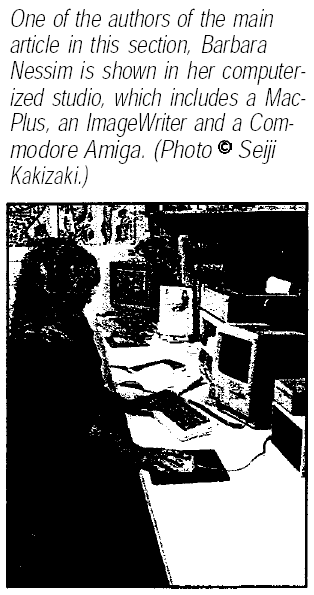
THE MARRIAGE OF COMPUTERS, COLOR COPIERS AND FAXES
Does a laser color system- that is, a color copy machine-belong in the electronic studio? Does a fax machine? The list can go on. They are electronic devices (or devices somehow connected to electronics), and designers are using them for creative purposes or for communication with clients and associates. Before answering these questions, we prefer to point to the determining issue of integration. The electronic stu- dio is not only a place for individualized creative design, but also one for interaction and cooperation. This is why each piece of equipment should be considered not only in terms of performance and price, but also-if not primarily-in terms of integration. Does it “speak” to other machines? Does it support information exchange? Does it fulfill several functions in a reliable way that can be programmed according to design needs? Can it be connected to both the outside world (the broader context of information processing) and the inside community of those consti- tuting the backbone of the studio-the artists, designers, illustrators and architects?
COLOR COPIER – One of the most technologically impressive machines available today-discovered and used by designers ln very creative ways-is the Canon Color Laser Copier. (See the article in Section 4, titled “Color Laser Copying.”) It is really a scanner, an image processing machine (that can alter the image, change colors, affect local and global characteristics), and a laser color printer (with a speed of five prints per minute). It features 50 to 400 percent zoom functions (reduction and enlargement), scaling, color conversion, color balance, image composition and even layout, as welI as the ability to input images from printed matter and from 35mm slides and negatives. The only limitation of this exceptional machine-to date-is that it is not designed for integration. A very inventive designer who wants to push technology to new limits can perhaps overcome this limitation and make the machine “talk” to others.
THE FAX – The same holds true for the fax machines. In reality, any computer display can be a fax terminal, any computer can process fax information, and any printer can generate a fax image. Slowly, this idea is picking up-you can find fax boards for your computer-and we anticipate that the electronic studio may just contribute to the demise of the fax, while maintaining the ability to exchange visual documents as required for our times.
SCANNERS – Here is a representative sampling of some scanning equipment:
– ProViz (video input, 4 bits per pixel, 16 gray levels), by Pixelogic
– Magic (video input, 8 bits per pixel, 266 gray levels), by New Image Technology
– MacScan (black & white, sheetfed; comes also as flatbed), by New Image Technology
– Jet Reader (sheetfed, 4 bits per pixel, 16 gray levels), by Datacopy
– Model 730 (flatbed, 4 bits per pixel, 16 gray levels), and Model 840 (flat-bed, 8 bits per pixel, 256 gray levels), by Datacopy
– PC Scan, PC Scan+ (sheetfed, black &white), by Dest
– PC Scan 1000, PC Scan 2000 (sheetfed, 4, respec- tively 8 bits per pixel, 16, respectively 256, gray levels), by Dest
– Scan300 w/C-Scan 1.5 (Abaton)
– Scan300/FB w/C-Scan 1.6 (flatbed, 4 bits per pixel), by Abaton
– ScanJet (flatbed, 4 bits per pixel, 16 gray levels), by Hewlett-Packard
– Imagizer (video, 8 bits per pixel, 256 gray levels), by Comtrex
– Thunderscan (input through the Image Writer printer, 5 bits per pixel, 16 gray levels), by ThunderWare
– MS-3OOA, MS-300C (sheetfed, black and white), by Microtek
– MSF-300C, MSF-300G (flatbed, black and white, respectively 8 bits per pixel, 256 gray levels), by Microtek
– TZ-3 (scanning table, 8 bits per pixel, 256 gray lev- els), by Truvel
– AST Turboscan SF, AST Turboscan FB (she&fed, respectively flatbed, black and white) by AST Research
LASER PRINTERS Here is a representative sampling of some laser printers that are equipped with Post- Script software:
– NBI, Inc, Model 908 . QMS-PS 800 II, 810
– Linotype Company, Lmotronic 100,300,500
– Texas Instruments OmniLaser 2106
– Texas Instruments OmniLaser 2108,2115
– The Laser Connection PS Jet/PS Jet+ 0 Dataproducts Corp. LZR 2665
– Qume Corporation ScriptTEN
– Digital Equipment Corp. PrinterServer 40, Scriptprinter
– AST Turbo Laser/PS 0 IBM 4216-020 Per- sonal Pageprlnter
– Varityper VT-600
– Apple Computer, Inc. LaserWriter IINTm IINTX
– Quadram Quadlaser PS l Agfa-Gevaert P4OOPS
– General Computer Business LaserPrinter Plus . WangLCS15
– NEC Information Sys- tems SilentWriter LC-890
– Diconix Dijit I/PS
– Apollo Computer, Inc. Domain/Laser 26
– QMS-PS 2400, QMS JetScript
Posted in Ubiquitous Computing & Digital Media

 Disrupt Science: The Future Matters
Disrupt Science: The Future Matters